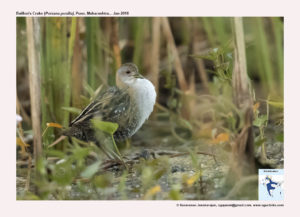Ballion’s Crake

Baillon’s Crake Porzana pusilla
Etymology :
- Porzana : Local Venetian names for smaller crakes
- Pusilla: Little
Vernacular name: Nepal, Bi: Jhilli, Pun: Chhota jal-bater, Guj: Baillon-ni santa-kukadi, Nani santhakukdi, Mar: Baillon Chi Fatakadi
Distribution in India: Breeds in Himalayas, Widespread Winter visitor and Passage Migrant in India.
Description: Size of 16-18 cm. It has a short straight bill, yellow or green without a red base. Adults have mainly brown upperparts with some white markings, and a blue-grey face and underparts. The rear flanks are barred black and white. They have green legs with long toes, and a short tail which is barred underneath. The sexes are similar but female often has rufous-brown streak, varyingly from over ear to complete eyestripe; sometimes paler grey on underparts than male (nominate race) and larger pale patch on chin.
Habitat: It is found in freshwater to saline, permanent to ephemeral wetlands with dense vegetation and often floating plants, including marshes, swamps, flooded meadows, margins of open water, peat bogs, interdune pans, irrigated crops, temporarily inundated depressions and marshy artificial wetlands; occasionally salt-marsh.
Food Habits: It eats adult and larval aquatic insects, including Coleoptera, Hemiptera, Odonata, Plecoptera, Phryganeidae, Culicidae, Annelida, molluscs, small crustaceans, small fish, green plant material, and seeds. It forages on mud, probing and taking prey from surface, and in shallow water, occasionally to belly depth, immersing bill to seize prey; probes into bases of decaying plants and among or under detritus, dead stems and roots; often forages while walking on floating vegetation and broken reeds, and while swimming; also dives for food. Normally forages close to, or within, dense cover; most active in early morning and from late afternoon to evening.
Breeding Habits: They breed in Europe in May–Jul; Morocco in May, Ethiopia in Jul; Tanzania, in Apr; Malawi in Jun, Zimbabwe in Jan–Mar; Botswana in Jan; May-Aug in Kashmir. They are monogamous and territorial; pair-bond maintained only while breeding. The nest is a shallow cup or platform of material available nearby, e.g. dead leaves, dry rush stems, grass or water weed; often with vegetation pulled over to form canopy; on ground in thick vegetation close to water, in soft grass or on tussock in water, sometimes anchored in water amongst growing rice crops or on floating vegetation; occasionally in or under low bush. Rather flimsy; material added during incubation, especially if water rises. Both sexes build the nest. Some nests have adjoining platform where young sit after hatching. They lay a clutch of 4–11 eggs; laid at daily intervals. The incubation period is 16–20 days, incubation done by both sexes. The hatching is asynchronous and the chicks are precocial and nidifugous. The chicks are fed and cared for by both parents, and brooded when small. They become self-feeding after a few days and independent before fledging. The fledging period is 35–45 days.
.